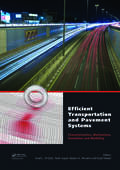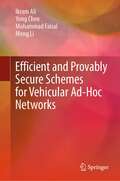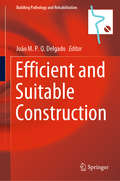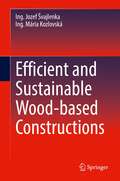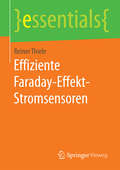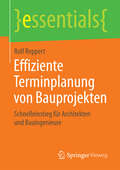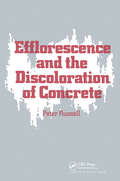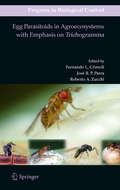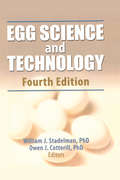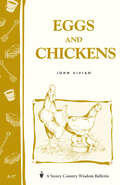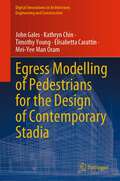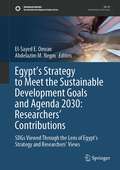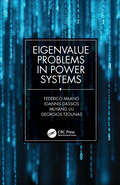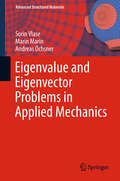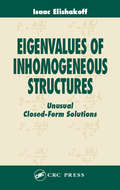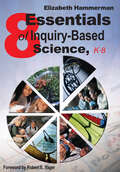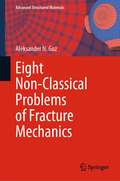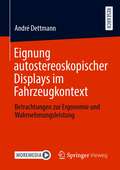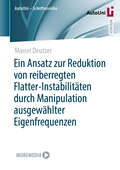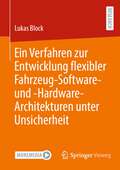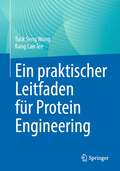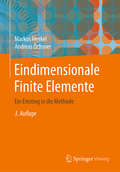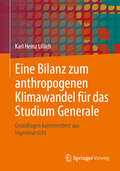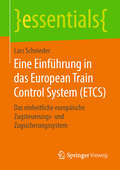- Table View
- List View
Efficient Transportation and Pavement Systems: Characterization, Mechanisms, Simulation, and Modeling
by Eyad Masad Imad L. Al-Qadi Tarek Sayed Nasser A. AlnuaimiInternationally, significant attention is given to transport sustainability, including planning, design, construction, evaluation, safety, and durability of the road system. The 4th International Gulf Conference on Roads: Efficient Transportation and Pavement Systems - Characterization, Mechanisms, Simulation, and Modeling, hosted by the University of Qatar, provided a forum for discussions of recent developments and research results and needs on transportation network optimization, traffic management, transportation safety, and pavement design, analysis, material characterization, modeling, and rehabilitation techniques. This book is a collection of 79 fully refereed papers and six keynote lectures.
Efficient and Provably Secure Schemes for Vehicular Ad-Hoc Networks
by Yong Chen Meng Li Mohammad Faisal Ikram AliThis book focuses on the design of secure and efficient signature and signcryption schemes for vehicular ad-hoc networks (VANETs). We use methods such as public key cryptography (PKI), identity-based cryptography (IDC), and certificateless cryptography (CLC) to design bilinear pairing and elliptic curve cryptography-based signature and signcryption schemes and prove their security in the random oracle model. The signature schemes ensure the authenticity of source and integrity of a safety message. While signcryption schemes ensure authentication and confidentiality of the safety message in a single logical step. To provide readers to study the schemes that securely and efficiently process a message and multiple messages in vehicle to vehicle and vehicle to infrastructure communications is the main benefit of this book. In addition, it can benefit researchers, engineers, and graduate students in the fields of security and privacy of VANETs, Internet of vehicles securty, wireless body area networks security, etc.
Efficient and Suitable Construction (Building Pathology and Rehabilitation #17)
by João M. P. Q. DelgadoThis book presents recent research in the area of hygrothermal building performance, acoustic and natural lighting performance in buildings, phase change materials (PCM) and energy storage. Discussing the state of the art in the field, and covering topics relevant to variety of engineering disciplines, such as civil, materials and mechanical engineering, it will appeal to scientists, students, practitioners, lecturers and other stakeholders.
Efficient and Sustainable Wood-based Constructions
by Ing. Jozef Švajlenka Ing. Mária KozlovskáThe book brings together surveys and analyses that increase awareness of wooden buildings in terms of sustainability and the benefits offered by modern wood-based construction systems in terms of building efficiency. The volume’s contribution to the understanding of efficient and sustainable wood-based constructions arises from the explanation of the authors’ methodology for the evaluation of sustainability and efficiency within selected phases of the life cycle of buildings, a technique that can be used for the evaluation of different types of structural systems and their comparison from various perspectives.
Effiziente Faraday-Effekt-Stromsensoren (essentials)
by Reiner ThieleReiner Thiele zeigt einen Weg an einem grunds#65533;tzlichen Problem der elektrischen Energietechnik vorbei, um die Messung von hohen elektrischen Str#65533;men ohne Eingriff in den Messgr#65533;#65533;enkreis zu erm#65533;glichen. Diese Schwierigkeiten l#65533;st der Autor effizient durch die Erfindung der Verfahren und Schaltungsanordnungen zweier Faraday-Effekt-Stromsensoren zur Messung elektrischer Str#65533;me mit automatischer Elimination der Doppelbrechung der Sensor-Lichtwellenleiter und eines optischen Kopplers sowie streng linearer Beziehung zwischen Messwerten und Messgr#65533;#65533;e. Diese aufwandsarmen Stromsensoren ben#65533;tigen im Gegensatz zu anderen L#65533;sungen f#65533;r ihre Funktion weder Polarisatoren, Spiegel noch Integratoren.
Effiziente Terminplanung von Bauprojekten: Schnelleinstieg für Architekten und Bauingenieure (essentials)
by Rolf ReppertRolfReppert hat ein prägnantes Einführungswerk zur Planung und Kontrolle vonTerminen in der Baubranche verfasst. Der Leser wird schnell über die einzelnenPlanungsschritte an das effiziente Arbeiten mit einer EDV-gestützten Terminplanungherangeführt. Damit kann er in kurzer Zeit einen guten Terminplan aufstellenund hat damit eine Grundlage für die effektive Terminkontrolle seinerBauprojekte, die regelmäßig erfolgen muss. Der aktuelle Status muss immer imTerminplan abgebildet sein. Änderungen und Ergänzungen können im EDV-gestütztenArbeiten auch nachträglich erfolgen. Dadurch ist eindeutig ablesbar, ob dasProjekt rechtzeitig enden wird oder nicht. Nur so sind Verzüge rechtzeitig zuerkennen und man ist in der Lage, Gegenmaßnahmen zu ergreifen.
Efflorescence and the Discoloration of Concrete
by P RussellThis detailed book covers causes, soluble salts, prevention and removal of discoloration. it also provides a checklist for the practitioner.
Effluent Dye Removal by Microwave-Assisted Activated Carbon (SpringerBriefs in Molecular Science)
by Rehab AbdelghaffarThis book explores the potential of advanced microwave techniques, specifically microwave-assisted pyrolysis, for the production, adsorption, and regeneration of activated carbon (AC) as a promising solution to address wastewater pollution caused by dyes. The author begins with a chapter devoted to the environmental implications of water pollution and emphasizes the characteristics of dyes and various treatment techniques for their removal. The advantages and disadvantages of commercially available activated carbon are also discussed, along with the determinants for effective adsorption using high-quality activated carbon. Additionally, the chapter delves into the different types of adsorbents, including agricultural and industrial waste, as well as bioadsorbents such as microorganisms. In Chapter 2, readers will find the latest trends in using microwave techniques for the activation process. In this chapter, the author elucidates the characteristics and mechanism of microwave heating and compares it with conventional heating methods. The advantages of microwave techniques, such as improved activation procedures and the influence of different factors, are explored. Various modeling and optimization approaches for adsorption and different techniques for analyzing the surface chemistry of activated carbons are also discussed. Furthermore, the chapter showcases the applications of microwave-assisted activated carbon for dye removal. The book closes with a chapter devoted to the recycling and regeneration of spent activated carbon (SAC) using microwave techniques. In this chapter, the author examines the procedures for SAC regeneration through microwave-assisted pyrolysis and highlights the advantages over conventional heating methods. The applications of microwave-assisted activated carbon regeneration and other miscellaneous technologies utilizing microwave heating for AC production and SAC regeneration are also explored. Given its breadth, this book is a valuable resource for researchers, professionals, and policymakers in the field of environmental science and engineering.
Egg Parasitoids in Agroecosystems with Emphasis on Trichogramma
by Fernando L. Consoli Roberto A. Zucchi José R. ParraEgg Parasitoids in Agroecosystems with emphasis on Trichogramma was conceived to help in the promotion of biological control through egg parasitoids by providing both basic and applied information. The book has a series of chapters dedicated to the understanding of egg parasitoid taxonomy, development, nutrition and reproduction, host recognition and utilization, and their distribution and host associations. There are also several chapters focusing on the mass production and commercialization of egg parasitoids for biological control, addressing important issues such as parasitoid quality control, the risk assessment of egg parasitoids to non-target species, the use of egg parasitoids in integrated pest management programs and the impact of GMO on these natural enemies. Chapters provide an in depth analysis of the literature available, are richly illustrated, and propose future trends.
Egg Science and Technology (Professional Bks.)
by William J Stadelman Debbie Newkirk Lynne NewbyHere is the complete source of information on egg handling, processing, and utilization. Egg Science and Technology, Fourth Edition covers all aspects of grading, packaging, and merchandising of shell eggs. Full of the information necessary to stay current in the field, Egg Science and Technology remains the essential reference for everyone involved in the egg industry. In this updated guide, experts in the field review the egg industry and examine egg production practices, quality identification and control, egg and egg product chemistry, and specialized processes such as freezing, pasteurization, desugarization, and dehydration. This updated edition explores new and recent trends in the industry and new material on the microbiology of shell eggs, and it presents a brand-new chapter on value-added products. Readers can seek out the most current information available in all areas of egg handling and discover totally new material relative to fractionation of egg components for high value, nonfood uses.Contributing authors to Egg Science and Technology present chapters that cover myriad topics, ranging from egg production practices to nonfood uses of eggs. Some of these specific subjects include:handling shell eggs to maintain quality at a level for customer satisfactiontrouble shooting problems during handlingchemistry of the egg, emphasizing nutritional value and potential nonfood usesmerchandising shell eggs to maximize sales in refrigerated dairy sales casesconversion of shell eggs to liquid, frozen, and dried productsvalue added products and opportunities for merchandising egg products as consumers look for greater convenienceEgg Science and Technology is a must-have reference for agricultural libraries. It is also an excellent text for upper-level undergraduate and graduate courses in food science, animal science, and poultry departments and is an ideal guide for professionals in related food industries, regulatory agencies, and research groups.
Eggs and Chickens: Storey's Country Wisdom Bulletin A-17 (Storey Country Wisdom Bulletin Ser.)
by John VivianSince 1973, Storey's Country Wisdom Bulletins have offered practical, hands-on instructions designed to help readers master dozens of country living skills quickly and easily. There are now more than 170 titles in this series, and their remarkable popularity reflects the common desire of country and city dwellers alike to cultivate personal independence in everyday life.
Egress Modelling of Pedestrians for the Design of Contemporary Stadia (Digital Innovations in Architecture, Engineering and Construction)
by Timothy Young John Gales Kathryn Chin Elisabetta Carattin Mei-Yee Man OramThis book provides an understanding of people's accessibility needs, and the barriers that may affect people with different identities and circumstances (e.g. different levels of mobility, age, etc.) to alleviate any act of disabling a person and thus offer equal quality of life in the design of stadia. A lack of knowledge exists for stadia concerning demographics, specific accessibility and inclusive design solutions, available movement and behavioural data, and how future growth in attending disabled populations may affect the overall safety of circulation and evacuation in stadia. To address these needs a data collection and modelling were performed and are described in this book. The book recognizes that stadia design is at a revolutionary stage of advancement. Automated data collection technologies and methodologies are described where the authors work towards presentation of big data which can be used for future refinement of modelling technologies and AI routines.
Egypt’s Strategy to Meet the Sustainable Development Goals and Agenda 2030: SDGs Viewed Through the Lens of Egypt’s Strategy and Researchers' Views (Sustainable Development Goals Series)
by Abdelazim M. Negm El-Sayed E. OmranThis book focuses on Egypt as a representative example of emerging economies struggling to achieve their sustainable development goals (SDGs). The Egyptian government has launched Egypt’s Vision 2030 in line with the 2030 Agenda, also known as the Sustainable Development Strategy (SDS), which encompasses the economic, social and environmental dimensions of development. It is under the SDS that all development plans in Egypt are incorporated while at the same time being strongly guided by the SDGs. Aware of the principle of shared but differentiated responsibility, Egypt also recognizes that fundamental challenges remain, despite a strong willingness to achieve the SDGs. High birth rates, brain drain phenomena, water scarcity, migration, discrimination against women and girls, a growing informal sector and instability in neighboring states (especially Libya and Syria) are only some of the many hindrances to sustainable development.In order to address these challenges, Egypt relies heavily on the SDGs, which are aimed at transforming our world. Although there is an urgent need for a drastic change in the way we use the Earth, the question arises as to whether the SDGs are sufficient to facilitate such a transformation. This book explores the key environmentally related Sustainable Development Goals (SDGs) and offers a cutting-edge assessment of current progress with a view to reaching these objectives by 2030. The book highlights some of the key findings and ideas for how research may help achieve the 17 Sustainable Development Goals in enterprises. The book provides a useful framework that can help and aid the Egyptian government to assess the many goals and targets outlined in the 2030 Agenda. The analysis of Egypt can be used as a blueprint for other developing nations and globally in order to guide policy toward achieving the SDGs. Covering food security, water resilience, climate change, agronomics, rural life, environmental impact assessment as a tool for measuring the achievement of the goals, Egyptian education, the COVID-19 pandemic, cultural and societal dimensions, this book will be of great interest to students and scholars of sustainable development and climate change, as well as practitioners and policymakers involved in sustainable development and disaster management.
Eigenvalue Problems in Power Systems
by Federico Milano Ioannis Dassios Muyang Liu Georgios TzounasThe book provides a comprehensive taxonomy of non-symmetrical eigenvalues problems as applied to power systems. The book bases all formulations on mathematical concept of “matrix pencils” (MPs) and considers both regular and singular MPs for the eigenvalue problems. Each eigenvalue problem is illustrated with a variety of examples based on electrical circuits and/or power system models and controllers and related data are provided in the appendices of the book. Numerical methods for the solution of all considered eigenvalue problems are discussed. The focus is on large scale problems and, hence, attention is dedicated to the performance and scalability of the methods. The target of the book are researchers and graduated students in Electrical & Computer Science Engineering, both taught and research Master programmes as well as PhD programmes and it: explains eigenvalue problems applied into electrical power systems explains numerical examples on applying the mathematical methods, into studying small signal stability problems of realistic and large electrical power systems includes detailed and in-depth analysis including non-linear and other advanced aspects provides theoretical understanding and advanced numerical techniques essential for secure operation of power systems provides a comprehensive set of illustrative examples that support theoretical discussions
Eigenvalue and Eigenvector Problems in Applied Mechanics (Advanced Structured Materials #96)
by Andreas Öchsner Marin Marin Sorin VlaseThis book presents, in a uniform way, several problems in applied mechanics, which are analysed using the matrix theory and the properties of eigenvalues and eigenvectors. It reveals that various problems and studies in mechanical engineering produce certain patterns that can be treated in a similar way. Accordingly, the same mathematical apparatus allows us to study not only mathematical structures such as quadratic forms, but also mechanics problems such as multibody rigid mechanics, continuum mechanics, vibrations, elastic and dynamic stability, and dynamic systems. In addition, the book explores a wealth of engineering applications.
Eigenvalues of Inhomogeneous Structures: Unusual Closed-Form Solutions
by Isaac ElishakoffThe engineering community generally accepts that there exists only a small set of closed-form solutions for simple cases of bars, beams, columns, and plates. Despite the advances in powerful computing and advanced numerical techniques, closed-form solutions remain important for engineering; these include uses for preliminary design, for evaluation of the accuracy of approximate and numerical solutions, and for evaluating the role played by various geometric and loading parameters.
Eight Essentials of Inquiry-Based Science, K-8
by Elizabeth HammermanUnlock the wonder in each of your students through inquiry-based science! Are you both fascinated and baffled by inquiry-based science? Do you want to tap the strength of inquiry-based science to help your students build deeper understandings? Do you want to use inquiry-based science to foster high-quality instruction across the educational board? This guide provides clear and simple explanations for engaging students in meaningful and hands-on, minds-on ways of understanding science. Eight Essentials of Inquiry-Based Science, K-8 breaks each essential into sample lessons that include sample data, discussion questions, and tools such as graphic organizers and analogies. Hammerman draws on more than 20 years experience in the fields of science instruction and professional development to address basic and complex principles related to inquiry, including: How to discuss data, information, models, graphics, and experiences How to interact with one another to strengthen knowledge and skills How to extend learning through guided or open-inquiry investigations and research How to apply new learning and the best research-based practices for improving student achievement When you harness the immense power of inquiry-based learning, you can fully discover the inquisitive nature of each of your students!
Eight Non-Classical Problems of Fracture Mechanics (Advanced Structured Materials #159)
by Aleksander N. GuzThis book presents an analysis of eight non-classical problems of fracture and failure mechanics mainly obtained by research in the department of dynamics and stability of continuum of the S. P. Timoshenko Institute of Mechanics of the National Academy of Sciences of Ukraine (NAS of Ukraine). It focusses on the application of the 3D (three-dimensional) theories of stability, dynamics, and statics of solid mechanics to the investigation of non-classical problems of fracture and failure mechanics.
Eignung autostereoskopischer Displays im Fahrzeugkontext: Betrachtungen zur Ergonomie und Wahrnehmungsleistung
by André DettmannAutostereoskopische Monitore stellen eine neue Generation von Anzeigen dar, die eine Betrachtung von 3D-Inhalten ohne weitere Hilfsmittel ermöglichen. Diese Displays sind im Fahrzeugkontext als Mensch-Maschine-Schnittstellen generell geeignet und ermöglichen einem Fahrer im Vergleich zu konventionellen zweidimensionalen Anzeigen eine höhere visuelle Wahrnehmungsleistung. Für diese Arbeit wurden im Praxisfeld der Fahrer-Fahrzeug-Interaktion die Parameter der visuellen Wahrnehmungsleistung und der ergonomischen Beeinträchtigungsfreiheit in Relation zueinander gesetzt und bilden somit den Fokus der empirischen Arbeiten.
Ein Ansatz zur Reduktion von reiberregten Flatter-Instabilitäten durch Manipulation ausgewählter Eigenfrequenzen (AutoUni – Schriftenreihe #175)
by Marcel DeutzerAn welchen Strukturbereichen muss eine Bremsenkomponente des Bremssystems strukturell modifiziert werden, um eine ausgewählte Frequenz zu einem definierten Zielwert zu bringen und simultan weitere Frequenzen an deren Ausgangswerten halten? Mit der vorliegenden Arbeit wird zur Beantwortung dieser Frage eine Methode zur Eigenfrequenzoptimierung im Bereich der evolutionären Topologieoptimierung für binäre Entwurfsräume und strukturierte Rechengitter unter Einbindung eines Ansatzes zur Modenverfolgung entwickelt. Die Methode wird in einen Gesamtansatz zur Identifikation und Änderung von komplexen Eigenwerten eingebettet und auf ein Bremsengesamtmodell zur Vermeidung von Bremsenquietschen (Flatter-Instabilität) angewendet.
Ein Verfahren zur Entwicklung flexibler Fahrzeug-Software- und -Hardware-Architekturen unter Unsicherheit
by Lukas BlockIn diesem Buch wird ein Verfahren vorgestellt, das die Konzeption von flexiblen Fahrzeug-Software- und -Hardware-Architekturen unter hoher Unsicherheit unterstützt. Dafür wird ein neues Artefakt in den Entwicklungsprozess eingeführt: Die probabilistische Architektur. Sie beschreibt unsichere Zukunftsszenarien und Anforderungen sowie darauf aufbauend die Gemeinsamkeiten und Unterschiede möglicherweise notwendiger Architekturstrukturen. Durch die probabilistische Architektur wird Unsicherheit in der Architekturkonzeption mathematisch beschreibbar und durchgängig von den Anforderungen bis in die physische Produktstruktur abgebildet. Drei Gestaltungsprinzipien leiten zusätzlich die Modularisierung und Komponentenauslegung der probabilistischen Architektur methodisch an. In Summe ermöglicht das Verfahren deshalb die Bewertung, Steuerung und Kontrolle des zielgerichteten Einsatzes von Flexibilität in Fahrzeug-Software- und -Hardware-Architekturen. Beispielsweise kann dadurch die zukunftsgerichtete Auslegung von Sensor- oder Rechenressourcen im Automobil unterstützt werden. In der Validierung ergab sich für diesen Anwendungsfall eine Senkung der erwarteten Anpassungsaufwände von nahezu 13 %.
Ein praktischer Leitfaden für Protein Engineering
by Tuck Seng Wong Kang Lan TeeDieses Lehrbuch führt den Leser auf zugängliche und ansprechende Weise in die Grundlagen der Proteinexpression und -entwicklung ein. Verschiedene Fallstudien veranschaulichen jeden Schritt von der ersten Sequenzsuche in Online-Datenbanken über Plasmiddesign und molekulare Klonierungstechniken bis hin zur Proteinreinigung und -charakterisierung. Darüber hinaus erhält der Leser praktische Tipps für eine erfolgreiche Karriere als Proteiningenieur. Da das Protein-Engineering eine grundlegende Technik in fast allen molekularbiologischen Labors ist, richtet sich das Buch an fortgeschrittene Studenten und Doktoranden, die in der Molekularbiologie, Biotechnologie und verwandten wissenschaftlichen Bereichen arbeiten.
Eindimensionale Finite Elemente: Ein Einstieg in die Methode
by Andreas Öchsner Markus MerkelDer Grundgedanke dieser Einführung in die Methode der Finiten Elemente wird von dem Konzept getragen, die komplexe Methode nur anhand eindimensionaler Elemente zu erläutern. Somit bleibt die mathematische Beschreibung weitgehend einfach und überschaubar. Das Augenmerk liegt in jedem Kapitel auf der Erläuterung der Methode und deren Verständnis selbst. Der Leser lernt die Annahmen und Ableitungen bei verschiedenen physikalischen Problemstellungen in der Strukturmechanik zu verstehen und Möglichkeiten und Grenzen der Methode der Finiten Elemente kritisch zu beurteilen. Die Beschränkung auf eindimensionale Elemente ermöglicht somit das methodische Verständnis wichtiger Themenbereiche (z.B. Plastizität oder Verbundwerkstoffe), die einem angehenden Berechnungsingenieur in der Berufspraxis begegnen, jedoch in dieser Form nur selten an Hochschulen behandelt werden. Somit ist ein einfacher Einstieg – auch in weiterführende Anwendungsgebiete – durch das Konzept (a) Einführung in die Grundlagen (b) exakte Ableitung bei Beschränkung auf eindimensionale Elemente (und in vielen Fällen auch auf eindimensionale Probleme) (c) Umfangreiche Beispiele und weiterführende Aufgaben (mit Kurzlösung im Anhang) gewährleistet.Zur Veranschaulichung wird jedes Kapitel sowohl mit ausführlich durchgerechneten und kommentierten Beispielen als auch mit weiterführenden Aufgaben inklusive Kurzlösungen vertieft.
Eine Bilanz zum anthropogenen Klimawandel für das Studium Generale: Grundlagen kommentiert aus Ingenieursicht
by Karl Heinz LillichIn diesem Buch wird, in Hinblick auf das, durch die verschiedenen Wetterparameter festgelegte Klima und die damit verbundene Definition einer globalen Erdtemperatur der Einfluss der anthropogenen Treibhausgasemissionen anhand von vorliegendem Datenmaterials dargelegt. Im Wesentlichen geht es dabei um die Verhältnisse in der Bundesrepublik Deutschland seit der Wiedervereinigung, also ab 1990 bis zum Jahr 2020, und deren Vergleich mit den globalen Gegebenheiten. Es werden die für das Temperaturgleichgewicht der Erde maßgebenden Strahlungsbilanzen nachvollzogen und das Zusammenspiel zwischen der atmosphärischen Treibhausgaskonzentration und den Anomalien der Erdtemperatur dargelegt, ebenso die sich als Konsequenz aus dem Klimawandel rekrutierenden politischen und gesellschaftlichen Aktivitäten. Ausgehend von den diesbezüglich vorliegenden Bilanzdaten werden die Bedeutung der Kernenergie und die Problematik der mit dem Einsatz fossiler Brennstoffe zur Energieversorgung verbundenen Schadstoffemissionen, vornehmlich das Kohlendioxid CO2 betreffend, insgesamt und unter Bezug auf den Energiebedarf bestimmter Sektoren behandelt. Dem Ausstieg aus der konventionellen Energieerzeugung werden, unter Bewertung der ökologischen und ökonomischen Aspekte, die alternativ nutzbaren erneuerbaren Energien gegenübergestellt. Besondere Beachtung findet der Einfluss des menschlichen Umweltverhaltens auf den Klimawandel und die Auswirkung der bis jetzt unaufhaltsam ansteigenden Weltbevölkerung auf einen nachhaltigen Umgang mit den natürlichen Ressourcen. Des Weiteren werden die Folgen des anthropogenen Klimawandels zusammenfassend erörtert und die Voraussetzungen und Maßnahmen formuliert, mit denen die Hoffnung bestehen soll, die Zielsetzung, den Anstieg der globalen Erdtemperatur zu begrenzen, realisieren zu können.
Eine Einführung in das European Train Control System: Das einheitliche europäische Zugsteuerungs- und Zugsicherungssystem (essentials)
by Lars SchniederDieses Buch behandelt die wichtigsten Aspekte des European Train Control System (ETCS) als Bestandteil des European Rail Traffic Management System (ERTMS). Lars Schnieder führt, ausgehend von den rechtlichen Grundlagen, in die technischen Grundprinzipien von ETCS ein. Der Autor stellt den Aufbau- und die Wirkungsweise der unterschiedlichen Ausrüstungsstufen dar und beschreibt die einzelnen Komponenten der Fahrzeug- und Streckeneinrichtung. Mit den von ETCS unterstützten Betriebsarten wird aufgezeigt, wie ETCS in den verschiedenen Ländern in den Bahnbetrieb integriert werden kann. Durch die Darstellung grundlegender technischer Zusammenhänge und Sicherungsfunktionen wird ein Verständnis für das zukünftige einheitliche Europäische Zugsteuerungs- und Zugsicherungssystem geschaffen.
